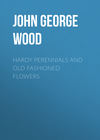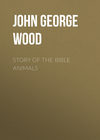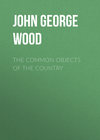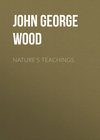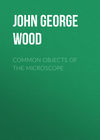Loe raamatut: «Hardy Perennials and Old Fashioned Flowers», lehekülg 13
Hedera Conglomerata
Conglomerate Ivy; Nat. Ord. Araliacæ
I do not introduce this as a flowering subject, but as a dwarf ornamental shrub; it differs so much from all other species and varieties of Ivy, and is so beautiful withal, that I trust no further apology is needed for giving it a place amongst decorative plants and shrubs. I have not been able to learn its habitat or origin; its stunted tree-like shape, together with other peculiarities, would indicate that it is a species; be that as it may, it has long had a place in English gardens, and yet it is seldom met with—it would be hard to explain why. On a bit of rockwork I have grown a specimen for nearly five years, and it was an old shrub when planted, yet it is not more than 2ft. in diameter and 1ft. high. It is much admired, and many notes have been taken of it. For rockwork, it is one of the best dwarf evergreen shrubs I know.
It has very small leaves, densely arranged in flat or one-sided wreaths. They seldom exceed 1in. in diameter, and are of various forms, as heart-shaped, sagittate, oval, tri-lobed, and so on. Some are notched, others slightly toothed, but many are entire. All are waved or contorted, wrinkled and thickened at the edges, where the younger leaves show a brown line; the under sides are pale green, and furnished with short stiff brown hairs, as also are the stout leaf stalks. The upper side of the foliage is a dark glossy green, with shadings of brown. In substance the leaves are leathery, inclining to stiffness. The stunted branches have a cork-like appearance as regards the bark, are diffuse, curiously bent, and sometimes twisted loosely together. It is of slow growth, more especially in the upward direction, and though provision may be made for it to cling and climb, and it has also well-formed roots on the branchlets, still, it assumes more the tree-shape. I never saw or heard of its flowering, much less that it ever produced seed; if it does not seed we are not only deprived of an ornamental feature belonging to the genus from the absence of berries, but it proves that it is only a variety of some species.
It may be grown in any kind of sandy soil, and nothing special whatever is needed. An open sunny situation will favour its form and colour of foliage; under trees I have found it to produce larger leaves of plainer shape and more even colour. During the winter it becomes a conspicuous object on rockwork, where it seems most at home. It may be propagated by cuttings, and spring is a suitable season to lay them in; in well dug light soil they soon make plenty of roots.
Helianthus Multiflorus
Many-flowered Sunflower; Nat. Ord. Compositæ
This fashionable flower is glaringly showy. Still, it is not wanting in beauty; moreover, it belongs to an "old-fashioned" class, and is itself a species which has been grown for nearly 300 years in English gardens. It was brought from North America in the year 1597, and during the whole of its history in this country, it can hardly ever have been more esteemed than it is to-day; it is very hardy, and in every way a reliable subject. Everybody knows the Sunflower, therefore no one will care to read a description of it; still, one or two remarks may, perhaps, be usefully made in the comparative sense, as this is a numerous genus. Many of the Sunflowers are annuals, to which this and others of a perennial character are much superior, not only in being less trouble and not liable to be out of season from mismanagement in sowing and planting, as with the annual sorts, but from the fact that their flowers are of better substance and far more durable; they are also less in size and more in number—two points of great gain as regards their usefulness as cut bloom. They are, besides, better coloured, and the flowering season more prolonged. Well-established specimens, two or three years old, will, in average weather, last in good form for fully six weeks. The colour (yellow) is common to the Sunflowers. This species has flowers which vary much in size, from 2in. to 6in. across, and they are produced on stems 3ft. to 6ft. high, well furnished with large heart-shaped leaves of a herb-like character, distinctly nerved, toothed, and rough.
Flowering period, August and September.
H. m. fl.-pl. is, of course, the double form of the above, the disk being represented by a mass of florets considerably shorter than those of the ray proper. The flowers are not produced in such large numbers as with the typical form, neither does the plant grow so tall, but the foliage is a little larger; these constitute all the points of difference which I have noticed. These forms of Sunflower are very effective—nowhere, perhaps, so much as amongst shrubs. The plants lift well, carrying a good ball that facilitates their being placed in pots even when in bloom, when, as I have lately seen, they may be used in a most telling manner with potted shrubs in large halls, corridors, and public buildings. In such places they get no sun to make them droop, and a good watering keeps them as fresh as if they had not been disturbed. Of the usefulness of this flower in a cut state nothing whatever need be said—who has not tried it? Doubtless, when it becomes unfashionable it will have fewer patrons, but it will be the same flower, richly beautiful—æsthetic. No special culture is needed, any kind of garden soil will suit it; if well enriched, all the better. Any situation will do but one too densely shaded. Propagated by splitting the roots after the plants have done flowering, or in spring.
Flowering period, August and September.
Helianthus Orygalis
Graceful Sunflower; Nat. Ord. Compositæ
Yet another Sunflower, and one, too, of the common yellow colour, and not otherwise attractive, as may be seen by the illustration (Fig. 47)—of course, I am now referring to the flower only. There are, however, features about this species which all must admire; stems 7ft. high, furnished with bright foliage, in the manner indicated, are not mean objects, even if topped with but a common yellow composite. This is a native of North America, and of recent introduction; it is a distinct species, and for foliage a prince among its fellows. I know not another to nearly approach it, H. angustifolius being perhaps the nearest, but that species has never with me proved of more than a biennial character, and its leaves, though long and narrow, are irregular and herby.
The flowers need not be further described beyond saying that they are borne on short side shoots, near the top of the main stems, but they harmonise with the general arrangement of foliage, and, indeed, from their bract-like leafiness, somewhat enrich it. This is one of the latest-blooming Sunflowers. The leaves are 5in. to 8in. long, and ½in. to 1in. wide, the lower half on the stems droop, though they are of good substance; the upper half bend gracefully, and, from their close arrangement, all but hide the stem. At the axils of the larger leaves, tufts of smaller (much smaller) leaves appear, causing the long stems to be top-heavy. Still, they wave and bend during the strongest winds without supports or damage. It will be seen that the usefulness of this plant consists in its distinct form and tallness, and that it is effective is without doubt. Among low shrubs, or with other tall things, will prove suitable quarters for it.

Fig. 47. Helianthus Orygalis.
(One-eighth natural size; flower, one-fourth natural size.)
Any kind of soil will do, shelter from the wind being the most important, and perhaps the only point to study when planting. It is propagated by root divisions when the tops have withered.
Flowering period, September and October.
Helleborus Abchasicus
Abchasian Hellebore; Nat. Ord. Ranunculaceæ
This is a native of the Caucasus, and in this climate, where it has been cultivated about fifteen years, it retains its foliage through the winter in a green state. It is a free grower, and flowers well, having a somewhat slender habit. It is sometimes described as having green flowers, but more often as having purple ones. It may be useful to remember that there are varieties, and it is likely that, even in the so-called green flowers, traces of purple will be seen. Not only is it a fact that this species, like H. purpurascens and H. niger, is far from fixed as regards depth of colour, but it is said to be one of the parent forms of some of the fine hybrids. These considerations may help to reconcile the apparently conflicting descriptions as regards bloom colour.
The flower stems are 12in. to 18in. high, distantly forked twice, and of a purplish colour. The flowers are produced in threes and fours on each of the branchlets, are inclined to purple, over 2in. across, and nodding; sepals oval, waved, and set well apart at the outer ends; petals scale-like, green, and numerous; anthers a beautiful delicate yellow; leaves of the flower stems few, small, and of irregular form, notched, finely serrate, and of a purplish-green shade; in their young state more especially does the purple prevail on the under surface—they are, in fact, nearly the colour of the flowers. The radical leaves are many, nearly a foot in diameter, of a dark green colour, and leathery substance; the leaflets are rather distant from each other, forming a noble pedate leaf; they are somewhat one-sided, slightly waved, sharply and regularly toothed nearly all their length. From this description it will be inferred that this is one of the most distinct species, and such is truly the case. Moreover, it has a bold and rich effect. The older radical foliage, with its long stalks, is for the most part spread on the ground, when the new erect flower stems, furnished with small leaves and nodding buds and blossoms, all of a shining purplish colour, form a peculiar but pleasing contrast, not nearly so marked in any other species with which I am acquainted. There is a variety called H. A. purpureus, in allusion to the colour of the flowers being a little more purple.
This Abchasian species and its varieties are not widely distributed; they are to be obtained, and need no longer be found only in rare collections. It is desirable in every way for the garden, where it forms a most ornamental object during winter. Its flowers last for four or five weeks, and in a cut state they form rich companion bloom to the white Christmas Rose.
A good fat loam suits them; the position should be rather shady and moist, but by all means well drained. A top dressing of good rotten manure, after all have done blooming, about the end of March, is a great help to them. All the Hellebores may be easily increased by root divisions, but the stock should be strong and healthy. Roots affected with the least rot or canker should be discarded, as from their slowness of growth they will not be worth garden space. Seed may also be raised, but unless sown as soon as it is ripe germination is less certain, and always slower in proportion to the length of time it has been kept dry. I may add that, in February (1883), I noticed a pot, sown with Hellebore seed in February of 1880; a few were just pushing through the mould. The seed was sold to me as the produce of 1879. Since 1880 I have sown seed ripened on plants that were bloomed for indoor decoration, it being ready about February. From this I had nice little plants in less than twelve months. But by seed the process of propagation is slow, and not advisable unless the object is to obtain new varieties—a very easy matter, by the way, with this family, if the simple rules of cross-hybridising are applied.
All the Christmas Roses should be so planted that they may be conveniently shaded during their blooming time. They mostly flower during the dullest part of the year, and the blossom, more especially the white kinds and those with metallic hues, unless protected, become damaged with mud splashes. Hand-lights or bell-glasses should be freely used.
Flowering period, January to March.
Helleborus Antiquorum
Ancient Hellebore; Nat. Ord. Ranunculaceæ
In what sense this specific name is applied, or which meaning of the word is supposed to be exemplified in this plant, I have no means of being certain. It is very probable that the name is in reference to its "old-fashioned," but beautiful, flowers; that they are "worthy," "dearer, more acceptable," and of "more esteem and account," is likely to be the verdict of every amateur who grows this kind successfully, for a more lovely flower could hardly be desired—large, white, softly toned with pink and grey. Sepals very large, incurved, overlapping each other, having the appearance of being semi-double, and being of good substance. The petals are small, short, of a lively green, and numerous. It is a bold and effective flower, but to see it in its full beauty it should be gathered spotlessly clean, as grey and pink tints are ugly when soiled. The leaves accompanying the flowers are of the previous season's growth, and are produced on slender round stalks, 1ft. to 1½ft. long, and much thickened at their junction with the leaves. The latter are nearly a foot across, pedate, or palm-shaped; the segments or leaflets are sub-divided and of irregular form, but mostly ovate, lance-shaped, finely and sharply toothed, and of a dull green colour. In a rich and free loam this kind proves a good grower, and when, in January, it is putting up its flower stalks, the buds being well developed and coloured from the time they appear above the earth, furnished with "floral leaf," in which respect it differs from the common Christmas Rose, it causes a pleased surprise that such a pure and delicate looking blossom can develop and mature in the depth of winter. As a cut flower by many it would be preferred to the better-known H. niger, not only for its antique tints, but for the fine cup form, which is constant, and the overlapping, incurved edges of the sepals. Altogether, its form is distinct, and when used in small glasses as single specimens, or, at most, accompanied only by a fern frond or a few blades of grass, it is a charming object.
Cultivation, as for H. Abchasicus.
Flowering period, January to April.
Helleborus Bocconi
Boccon's Hellebore; Nat. Ord. Ranunculaceæ
This, by many, is believed to be a species, but as such is unauthenticated. It is classed as a variety of H. purpurascens, compared with which, however, there are some well-marked distinctions. It is sometimes called H. multifidus, a name that suits it well, as being descriptive of its irregularly slashed foliage. It has but recently been brought under cultivation, and was found a native of the Apennines of Etruria. It proves perfectly hardy in this climate, and flowers in midwinter unless the season is very severe. As will be inferred from its near relationship to H. purpurascens, like that species it has non-persistent foliage, and the flower stems with their floral leaves appear before the leaves of the root. As a species or variety, whichever it may be, its more marked features are to be seen in the form or cut of the leaves.
As a garden flower it is not showy, yet it stands out well in a group; the nodding cup-shaped bloom is a bright green colour, and, for a time, the outer sides of the sepals only are seen; but when the flowers are more fully expanded, the numerous and somewhat long stamens (which are a creamy-white) seem to nearly fill the cup; to my mind, its greatest charm is in the fragrant odour which it yields, resembling that of elder flowers. A single blossom, if plucked dry and when in its prime, scents a small room; at such a stage, the anthers are loaded with pollen, and the tubular petals are richly charged with nectar. True, these last-named qualities are common to the genus, but when they are coupled with that of a sweet perfume, and produced by an open-air plant in winter, such a plant, be its blossoms green or red, is too valuable to be neglected. The flowers are borne on stems 6in. to 12in. high, which are twice and thrice branched or forked, having six to twelve blossoms on a stem. The flowers are bright green, nearly 2in. across, cup-shaped, and drooping. The sepals are somewhat oval, concave, and overlapping; petals very short, pale green, and evenly arranged; stamens creamy-white; styles green. The flowers are supported by floral leaves, which are much divided, in the way of those of H. purpurascens, but the segments are more irregular in shape. The radical leaves have long stems, and are palmate; divisions lobed. It dies down entirely during the autumn. Being a vigorous grower and free bloomer, and the flowers very durable withal, it should be largely grown for the sake of its sweet-scented blossoms for cutting purposes. There is an allied variety cultivated under the name of H. B. angustifolia (narrow-leaved). Assuming that H. Bocconi is a species, this is a variety but slightly removed from the typical form, inasmuch as the latter is not only much cut in the floral and radical leaves, but the shape is uncertain. This form, then, which, at least by its name, claims a specific feature in the cut of leaf, may be somewhat difficult to identify, more especially as there are no other dissimilarities of note. Seen, however, as a well-grown specimen, the feature of narrow foliage is not only manifest, but the plant is very effective.
Cultivation and flowering period, the same as with H. Abchasicus.
Helleborus Colchicus
Colchican Hellebore; Nat. Ord. Ranunculaceæ
A new species from Asia Minor. This is a strong grower and blooms well. The flowers vary in size and shade, but it may be said to be distinct in form and pronounced in colour, the latter being an uncommon feature with the Hellebores; either growing or cut it is indispensable to a group. Moreover, it is one of the best flowers of the genus, and would stand high even in a selection of the best six; it is one that should have a place in every collection.
It flowers amongst the previous season's foliage on branched stems; the sepals are somewhat round and flat, which gives the flower a stiff appearance. Still, from their unusual deep purple colour and the yellow stamens, together with the manner in which the sepals overlap each other, the flower is a most effective one; the petals are a bright green, and blend harmoniously with the yellow and purple parts. The leaves are very large, pedate, dentate, and distinctly veined. In a young state the foliage is richly coloured or tinted with "bloom." It enjoys a rich sandy loam and summer shade.
Cultivation, the same as for H. Abchasicus.
Flowering period, January to March.
Helleborus Cupreus
Coppery Hellebore; Nat. Ord. Ranunculaceæ
Notwithstanding its peculiar colour, as implied by the name, this is a pleasing border flower; moreover, the somewhat large flowers are also numerous; blossoms 3in. across, arranged in clusters of four and six, and handsomely furnished with new foliage, are no mean things in the depth of winter. The specific name of this Hellebore, though applicable, is not so definite as some, inasmuch as the colour to which it refers is that of several other species and varieties; there may be rather more of the metallic hue in our subject, but it is so slight as to be outside the pale of notice to the florist. The Coppery Hellebore is a native of mid-Europe, and is one of recent introduction into this country, where it proves hardy but annually dies down. It grows and flowers freely in January, the flower stalks appearing before the radical foliage, and attaining a height of nearly a foot.
The flower stems are a palish green, with purplish markings, are twice branched and furnished with floral leaves; the latter have ample stipules and seven longish divisions, which are well spread out, distinctly veined underneath, and coarsely toothed. The flowers are 2in. to 3in. across, sepals pointed, overlapping for about half their length, and well expanded; their outsides are of a purplish colour, which extends along the stalk; the inner surface of the sepals is a yellowish green, the whole being suffused with a metallic hue or "bloom"; the stamens and anthers are a creamy white, the petals short and apple-green. The flowers droop gracefully, and are rendered all the more pleasing by the floral leaves which immediately support them. The leaves of the root are large and pedate, the divisions wide apart and unevenly toothed; the under sides are distinctly veined with purplish-brown when in a young state. The habit is robust, and the bloom is produced well above the radical foliage. There is a peculiar beauty about a strong flowering specimen which would hardly be expected from the above description, and it is even more difficult for me to do it justice.
In a cut state a whole stem, with its flowers in different stages of development, is fine. The youngest rosy-purple buds, about the size of a cob nut; the more opened bell-shaped forms, just showing both the inner and outer colours of the sepals; these surmounted by the longer-stalked, fully expanded, but drooping flower, with its tassel-like bunch of stamens, and all finely interspersed with young leaves of two distinct colours, according to the side which meets the eye—all go to make it a charming decoration for indoors, and if cut clean it deserves a place for the whole week or more during which it remains in good form.
Cultivation, as for H. Abchasicus.
Flowering period, January to March.
